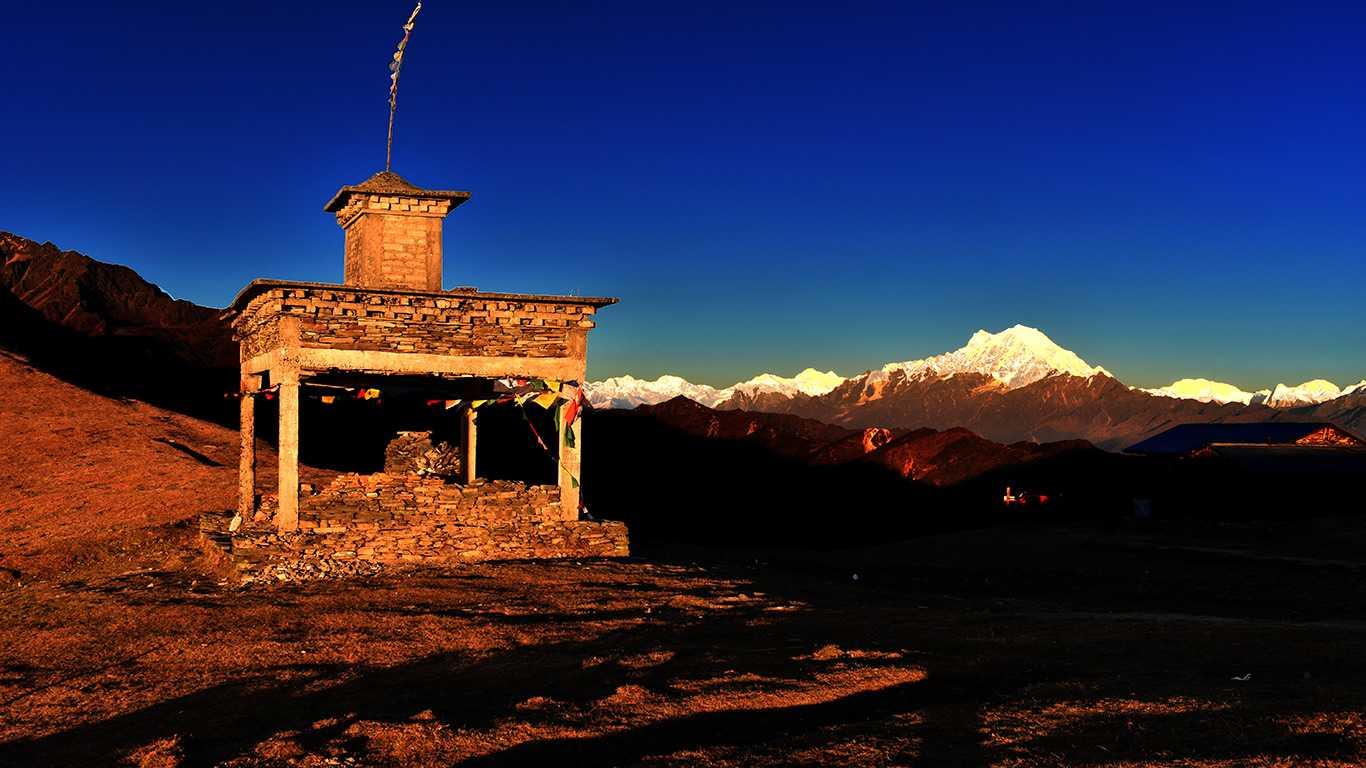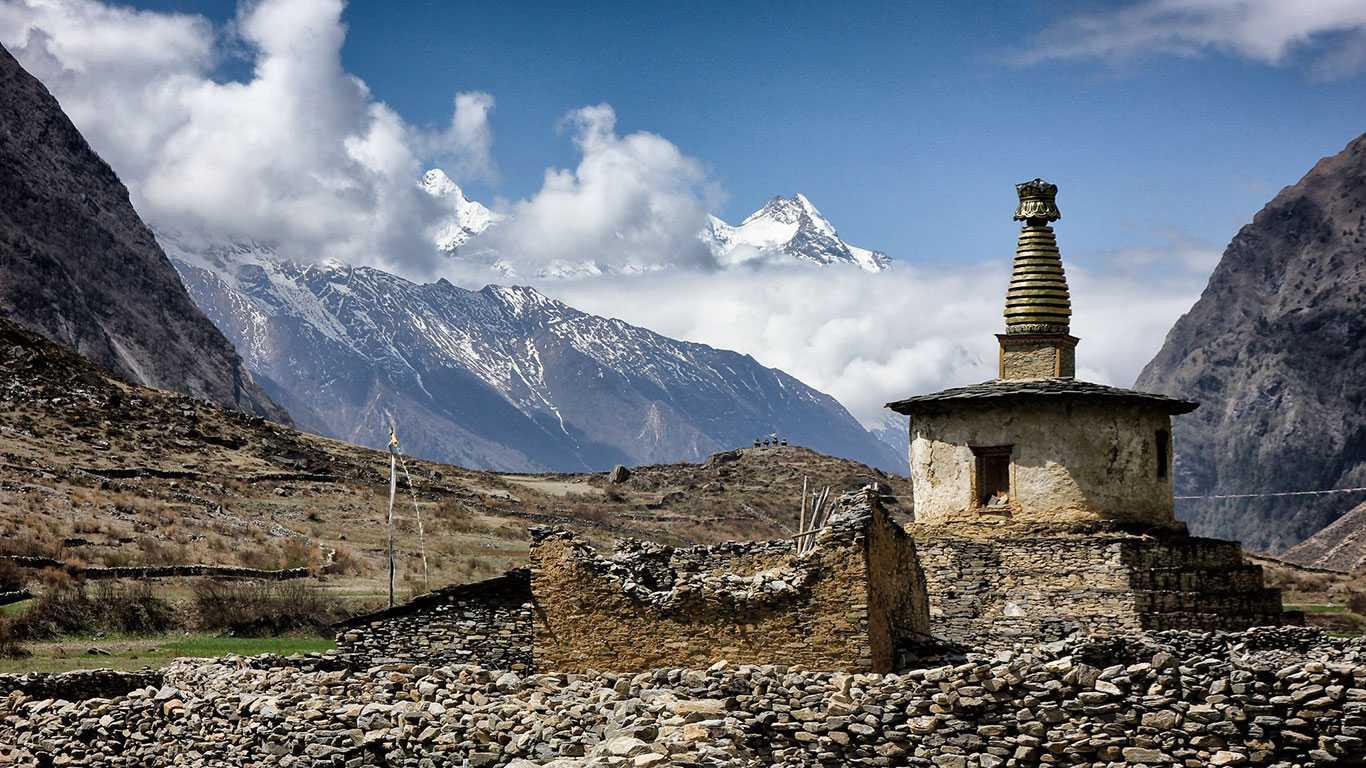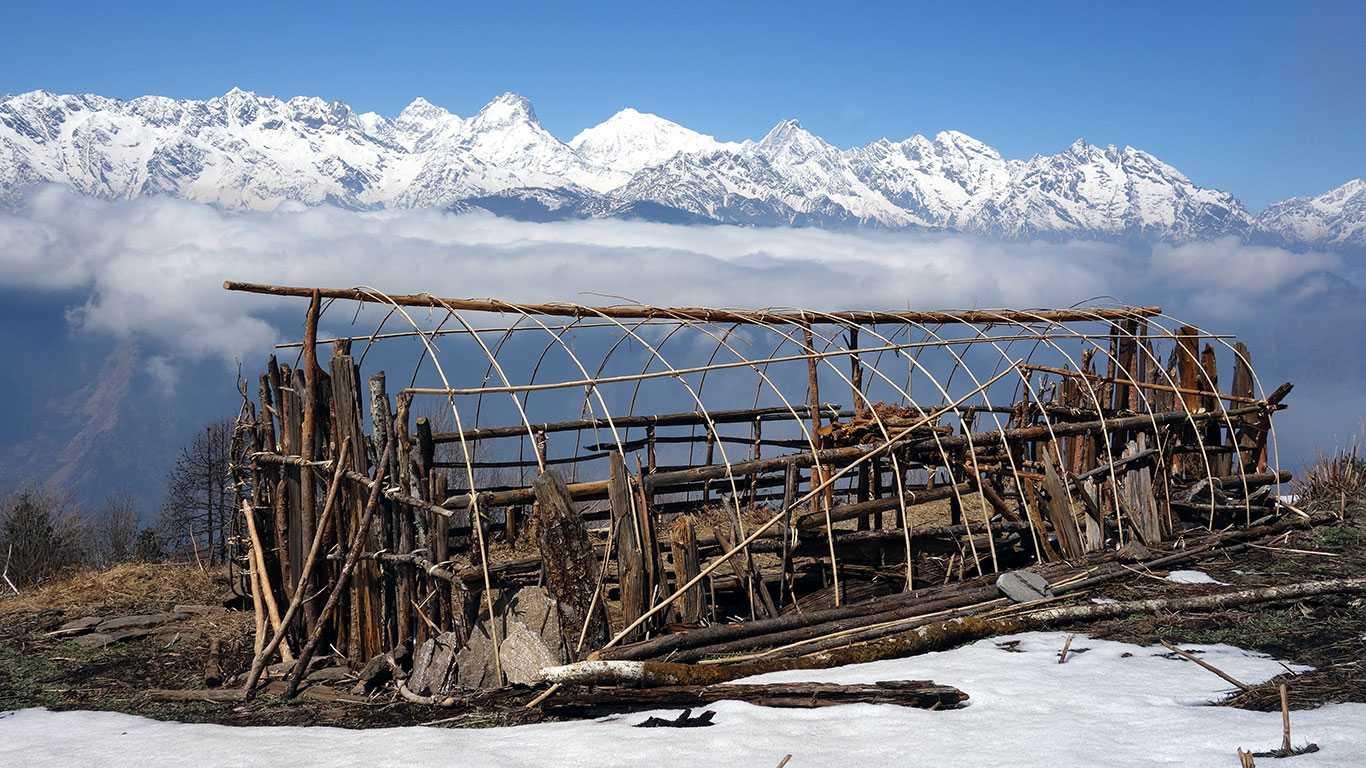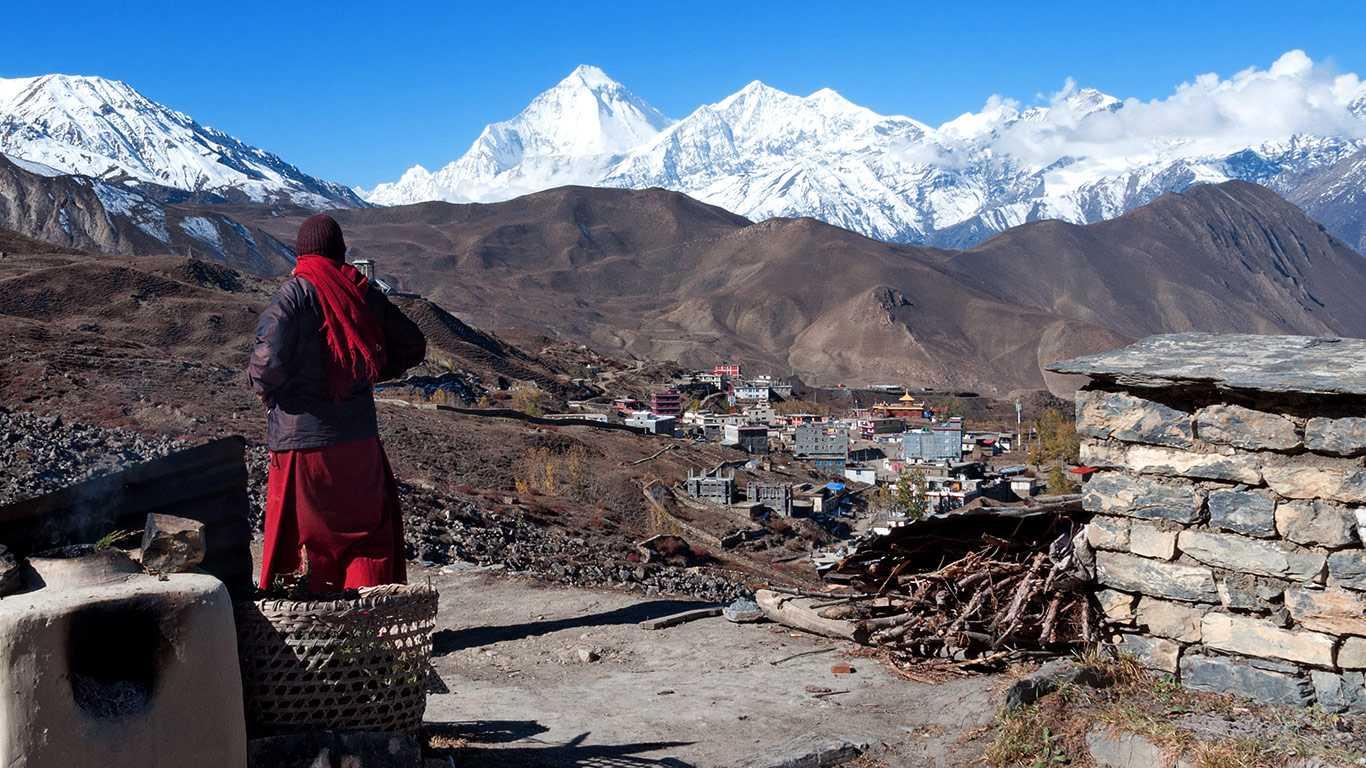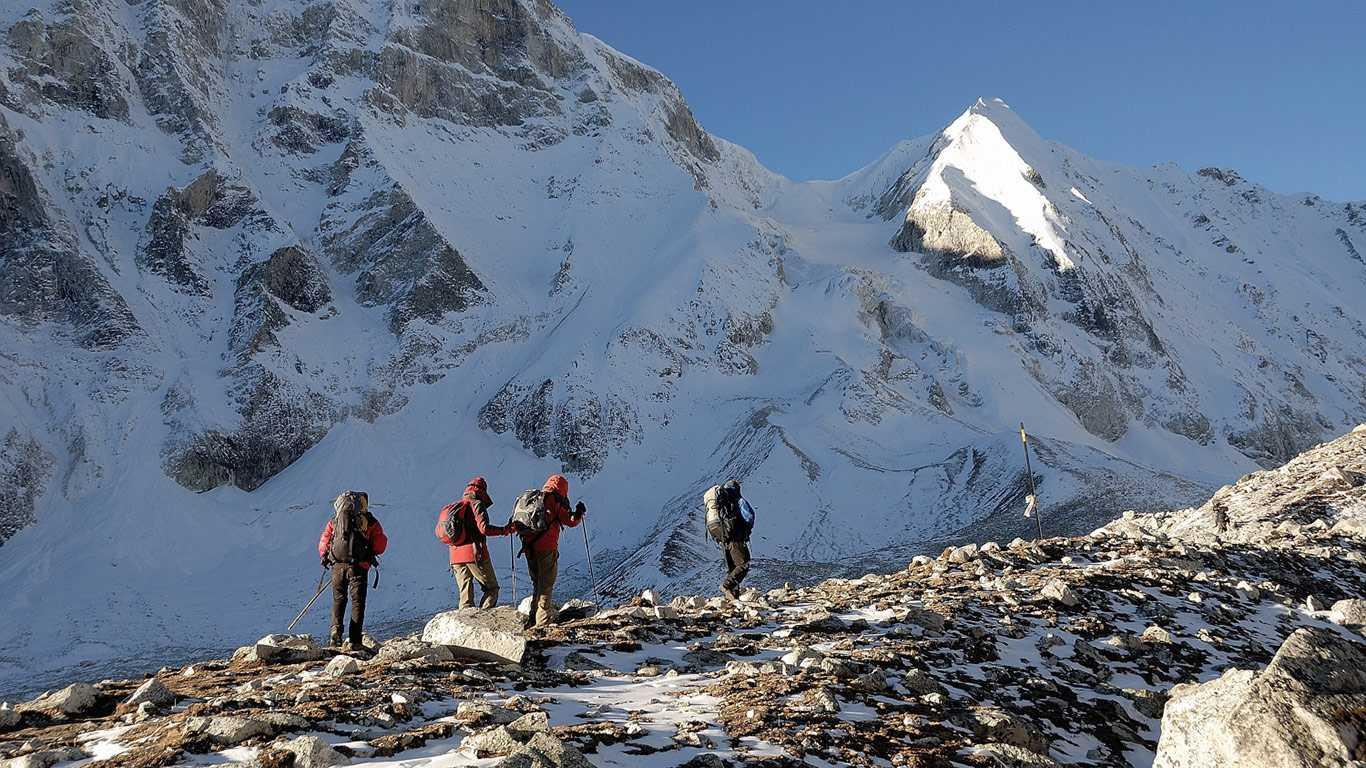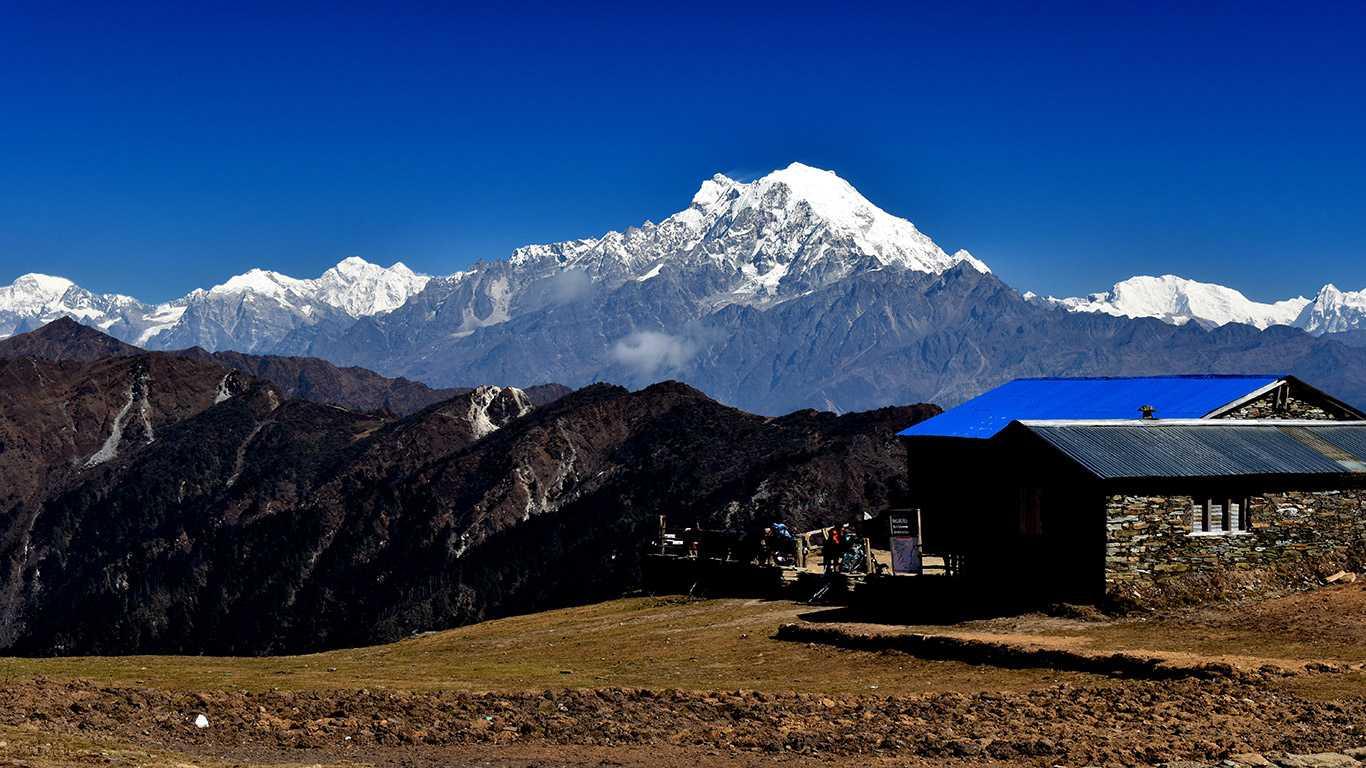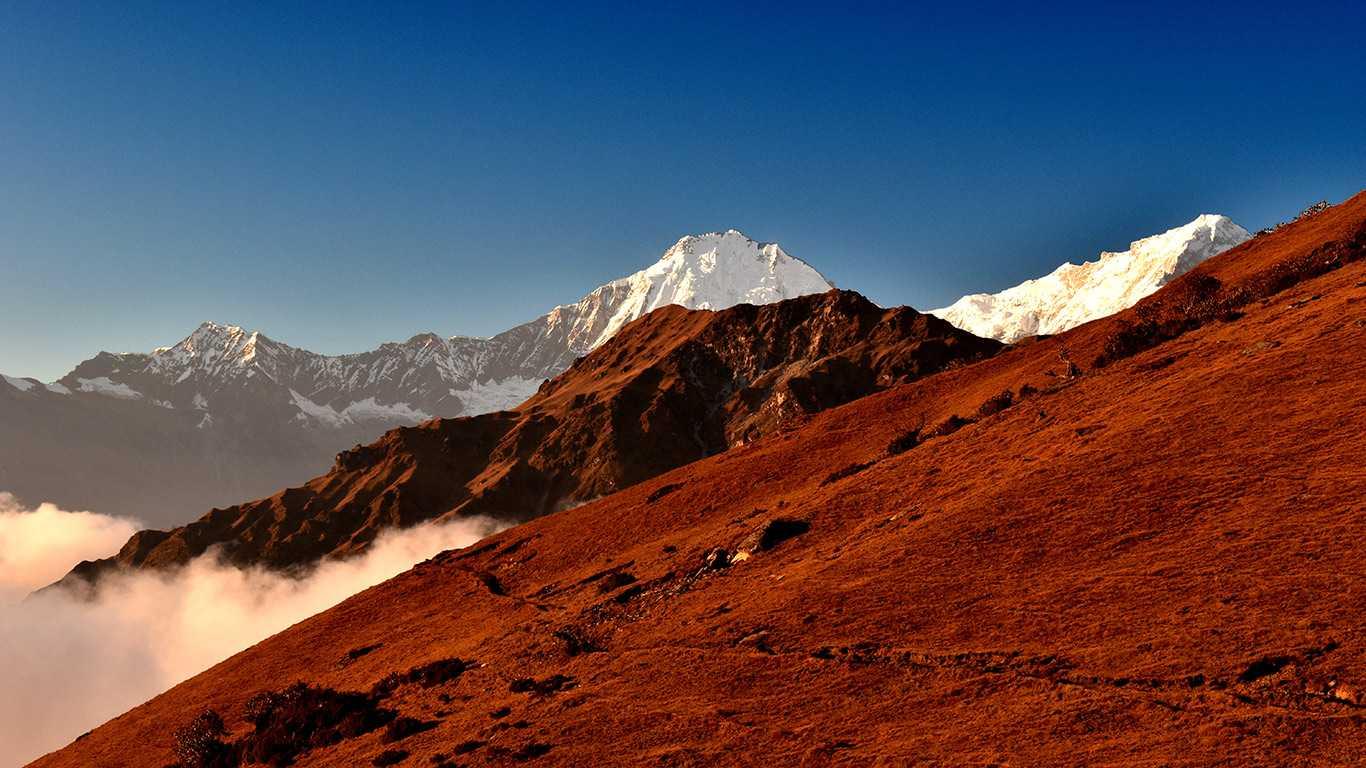
JOURNEY THROUGH PRISTINE BEAUTY
Ganesh Himal and Manaslu Treks stand perfect for those travelers who are seeking a peaceful and beautiful journey. It offers them a refreshing journey through the pristine mountains and biological diversity.
The Ganesh Himal Trek offers an exciting adventure in the wilderness. Travelers can pass through several valleys, forests filled with greenery, graceful waterfalls, and peaceful lakes. The Ganesh Himal region is also famous for its diversified flora and fauna. From finding plants like rhododendrons to watching animals like Himalayan Thar, Gaur, and musk deer live their normal lives, the Ganesh Himal region offers it all.
Similarly, the Manaslu Trek offers a challenging journey through the mountain roads around Mount Manaslu. This route passes through the Manaslu Conservation Area, allowing travelers to see a high concentration of biodiversity.
What could be better than walking through the pristine valleys with the majestic backdrops of the Ganesh Himal and Manasalu ranges? Both of these regions are bound to give travelers an other-worldly experience.


EXPLORING HIMALAYAN CULTURES
Ganesh Himal and Manaslu Treks may offer pristine beauty, but there is much more than that. The cultural experience and knowledge gained here will recharge or even increase your soul’s energy.
Immersing yourself in various ethnicities, like Tamang, Ghale, and Gurungs, allows for a better understanding of the culture and practices. Whether it is watching the process of Thangka painting of the Tamangs, the unique language of the Ghales, or the mesmerizing Ghatu dance of the Gurungs, there is no doubt that those who witness these will have the meaning of ‘beautiful’ changed for them.
When it comes to traditional foods, they are top-notch. Be it the softness of momos, the spiciness of thukpa, or the diverse flavors of daal bhat, they are going to fill both the stomach and soul of those who eat them.
Furthermore, learning traditional craftsmanship, such as pottery, weaving, and wood cutting, will give birth to the inner creativity of those who try.
Ganesh Himal & Manaslu Treks packages
Ganesh Himal & Manaslu treks offer a peaceful journey. It used to be an off-the-beaten-path trip in Nepal. But nowadays, the Manaslu Circuit trek has become a popular destination for tourists. However, there are places like Ruby Valley. It's still considered a hidden gem in the region.
The journey in Ganesh Himal & Manaslu offers a soul-stirring Himalayan scenery. Likewise, the place is also known for its sacred lakes and ancient monasteries. But the region is best known for housing the world’s 8th-highest mountain. Treks in Ganesh Himal & Manaslu are mostly moderate, with a few beginner-friendly.
Ganesh Himal & Manaslu span four districts. It covers Gorkha, Dhading, Rasuwa, and Nuwakot. The closest to Kathmandu is Ganesh Himal. It is located approximately 70 Kilometres away from the capital. The Manaslu Circuit trek is around 160 kilometres from Kathmandu.
Ganesh Himal Coordinates: 28.3794° N, 85.0564° E
Manaslu Coordinates: 28.5497° N, 84.5597° E
Why Trek in the Ganesh Himal & Manaslu?
The Ganesh Himal & Manaslu region offers a rare and rewarding blend. The region offers natural splendour and a deeply rooted culture.
The trails in this region take you through less crowded mountain villages. The traditions remain preserved. Travelers get a glimpse of an unfiltered Himalayan daily life.
Journey through lush river valleys. Experience the swaying suspension bridges. Ascend high alpine ridgelines with a majestic view of the peaks.
You experience heartfelt hospitality in the Ganesh Himal region. You find traditional homes, communal farming, and Buddhist shrines in Ganesh Himal.
You’ll experience stunning views in the Manaslu region. It also offers a spiritually rich time. Find century-old monasteries in the Manaslu region.
Trekkers pass through diverse ecological zones. They go through dense pine, rhododendron, and bamboo forests. Travelers also see high-altitude alpine meadows, glacial valleys, and barren Himalayan moonscapes.
The Ganesh Himal & Manaslu region also has a rich biodiversity. This area houses:
Red Pandas
Himalayan Tahr
Musk Deer
Snow Leopards
Many species of birds are fond in the Manaslu Conservation Area.
Find sacred sites in the Ganesh Himal & Manaslu region. Places like:
Ganesh Kunda
Tripura Sundari Temple
Ranchen Gompa
Mu Gompa
Lho Monastery
Scenic places in the Ganesh Himal & Manaslu region:
Panoramic Viewpoint of the surrounding Peaks
A twin Waterfall, Ganga-Jamuna
Sparkling rivers like Budhi Gandaki, Trishuli, and Bhote Koshi
How to reach the Ganesh Himal & Manaslu Region?
Reaching the Ganesh Himal & Manaslu region is mostly done by road. You’ll be leaving the hustling city for a quieter village. The nearest airport to the Ganesh Himal & Manaslu region is in Kathmandu. As such, a road trip is the only way to travel.
It takes around a four-hour drive from Kathmandu to reach Ganesh Himal. You’ll cover around 127 kilometres on this trip. Manaslu is a bit further away. As such, it will take around 9 hours to reach the starting point.
Here is a step-by-step guide:
Step 1. Arrival in Kathmandu Tribhuvan International Airport:
Trekkers start their journey in Kathmandu, Nepal’s capital city.
Spend a day or two organizing permits. Find and hire guides. Gather any last-minute gear.
Step 2. Choose Your Region:
For Ganesh Himal:
Main trailheads: Syabrubesi, Gatlang, Somdang, or Satdobato (Dhading)
Accessed via Pasang Lhamu Highway or Prithvi Highway
Distance from Kathmandu: ~70–100 km
Travel time: 6–8 hours by road
For Manaslu Region:
Main trailheads: Arughat, Soti Khola, or Machha Khola
Accessed via Prithvi Highway, then a branch road to Arughat
Distance from Kathmandu: ~130–160 km
Travel time: 8–10 hours
Step 3. Take the Road Trip
First Option: Public Bus
Public buses are a budget-friendly option. But they tend to be crowded and slow.
The bus for Syabrubesi leaves early from Gongabu Bus Park. You can take one for Arughat from the New Bus Park.
The journey will be long, bumpy, and winding.
Great option for cultural immersion, if you don’t mind the tight space.
Second Option: Hiring a Private Jeep
A private jeep is more comfortable, flexible, and time-saving.
It is ideal for a group of trekkers. Or someone with a tight schedule.
4WD vehicles become essential during the monsoon season. The rougher routes to Ganesh Himal require a four-wheel drive.
Cost of traveling by road:
To the Ganeh Himal Region:
Public Bus to Syabrubesi or Gatlang: $5-$10.
Hiring Private Jeep (4WD): $150-$200 per vehicle (Can split among the passengers)
Travel Time with the Public Bus: 6-8 hours
Travel Time with the Private Jeep: 4-6 hours
To the Manaslu Region:
Public Bus: $10-$15
Private Jeep (4WD): $180-$250 per vehicle (Can split with the passengers)
Travel Time with the Public Bus: 8-10 hours
Travel Time with the Private Jeep: 7-8 hours
Culture and community in the Ganesh Himal & Manaslu
The Ganesh Himal and Manaslu region is a mix of Hindu and Buddhist cultures. You will find Tibetan traditions, animism, and ancient rituals in the area.
Travelers can see prayer flags fluttering on the hilltops. Similarly, they are amazed by the ancient monasteries in the area.
People of Ganesh Himal:
The Ganesh Himal region is a blend of Buddhist and Hindu religions. You will find Gurungs, Tamangs, Magars, Chetris, and Brahmins in this region. Each group of people has its own personal language, dress, customs, and belief systems.
The villagers of the Ganesh Himal region follow age-old ways of life. The people keep busy with farming terraced fields and herding animals. Many found a new profession as teahouse owners. And those who run teahouses and homestays treat travelers as honoured guests.
People of the Manaslu Region:
The Manaslu region offers a completely different experience. It’s mostly shaped by isolation and closeness to the Tibetan border. The Manaslu region is the home to the Nubri and Tsum Valley people. They are descendants of Tibetan communities with their centuries-old customs and beliefs intact.
The Nubri people practice Tibetan Buddhism. They call Samagaun and Lho home. They build houses from stone that lasts the test of time.
Then there are the Tsumba people of the Tsum Valley. They are often referred to as the custodians of a “hidden valley of peace”. The Tumba people follow a monastic lifestyle. Moreover, at least one member of a family serves as a monk or a nun.
Varying Landscapes in the Ganesh Himal & Manaslu Region
You’ll find terraced farmlands, pine and fir forests, and a high-altitude alpine zone. The scene in the Ganesh Himal & Manaslu region varies. You can see green valleys, rivers, glaciers, and snow-capped mountains.
Popular Packages in the Ganesh Himal & Manaslu Treks
Manaslu Circuit & Thorong La Pass Trek
Trek to the vicinity of the world’s 8th highest peak. You can walk through the high alpine valley. Visit the Tibetan villages and monasteries. Here’s what you need to know about the Manaslu Circuit & Throng La Pass Trek package:
Duration: 24 Days
Max Altitude: 5,416 Meters
Coordinates: 28.7934° N, 83.9387° E
Difficulty: Intermediate Trek
Trip Start: Kathmandu
Trip End: Kathmandu
Accommodation: Tea Houses & Hotels
Meals: Included in the package
Temperature: 5 °C Day / -18 °C Night
Group Size: 2-16
Best Season: Spring/Autumn
Three Kunda Ruby Valley Trek
Look forward to exploring the hidden trails. Pass through Sing La, Pangsang La, and Magne Goth. Get ready to experience local traditions, culture, and lifestyle. And here is a list of what you need to know about the Three Kunda Ruby Valley Trek:
Duration: 19 Days
Max Altitude: Sing La Pass 4,220 Meters
Coordinates: 28.1599° N, 85.0534° E
Difficulty: Intermediate Trek
Trip Start: Kathmandu
Trip End: Kathmandu
Accommodation: Tea Houses & Hotels
Meals: Included in the package
Temperature: 15 °C Day / -2 °C Night
Group Size: 2-16
Best Season: Spring/Autumn
Manaslu Circuit and Tsum Valley Trek
Experience the hidden gem with the Manaslu Circuit and Tsum Valley Trek package. Find off-the-beat-trails, rich culture, and beautiful views. Discover centuries-old Gompas and Monasteries. And here’s a list of what you can expect from the package.
Duration: 22 Days
Max Altitude: 5,106 Meters
Coordinates: 28.659467° N, 84.583327° E
Difficulty: Intermediate Trek
Trip Start: Kathmandu
Trip End: Kathmandu
Accommodation: Tea Houses & Hotels
Meals: Included in the package
Temperature: 15 °C Day / -5 °C Night
Group Size: 2-16
Best Season: Spring/Autumn
Manaslu Circuit Budget Trek
Short treks including arrival and departure. You’ll find the best view of the majestic Mount Manaslu. Experience the mix of Nepali and Tibetan traditions. Finish the hike at Larkya La Pass. Here is other info on the Manaslu Circuit Budget Trek package:
Duration: 15 Days
Max Altitude: 5,106 Meters
Coordinates: 28.66392°N, 84.52035°E
Difficulty: Intermediate Trek
Trip Start: Kathmandu
Trip End: Kathmandu
Accommodation: Tea Houses & Hotels
Meals: Lunch and Dinner Not Included in the package
Temperature: 2 °C Day / -15 °C Night
Group Size: 2-16
Best Season: Spring/Autumn
Ganesh Himal Sing La Pass Trek
One of the best trekking trails in central Nepal. Plenty of flora and fauna on the route. Pass through Sing la pass, Pangsang pass, and Mangni pass. Find breathtaking views of the surrounding peaks. Here’s a list about the Ganesh Himal Sing La Pass Trek package:
Duration: 13 Days
Max Altitude: Sing La Pass 4,200 Meters
Coordinates: 28.2236° N, 85.1061° E
Difficulty: Intermediate Trek
Trip Start: Kathmandu
Trip End: Kathmandu
Accommodation: Tea Houses & Hotels
Meals: Included in the package
Temperature: Sing La Pass 10 °C Day / -3 °C Night
Group Size: 2-16
Best Season: Spring/Autumn
Rupina La Pass Trekking
Get a stunning view of Mount Manaslu, Himal Chuli, and other peaks. Experience rich culture and the tale of Gaje Ghale. The first Nepali to receive the Victoria Cross. Here is other information on the Rupina La Pass Trekking package.
Duration: 17 Days
Max Altitude: Rupina La Pass 4,610 Meters
Coordinates: 28.5500° N, 84.5575° E
Difficulty: Intermediate Trek
Trip Start: Kathmandu
Trip End: Kathmandu
Accommodation: Tea Houses & Hotels
Meals: Included in the package
Temperature: Rupina La Pass 7 °C Day / -5 °C Night
Group Size: 2-16
Best Season: Spring/Autumn
Tsum Valley Trek
Travel the off-the-beaten-path trails. The trekking path was opened in 2008, so it’s rather new. Experience Tibetan Buddhist culture. You’ll find a mesmerizing view of Ganesh Himal in the Tsum Valley Trek package. What you need to know:
Duration: 21 Days
Max Altitude: Mu Gompa 3,700 Meters
Coordinates: 28.6563° N, 85.1424° E
Difficulty: Beginner-Friendly Trek
Trip Start: Kathmandu
Trip End: Kathmandu
Accommodation: Tea Houses & Hotels
Meals: Included in the package
Temperature: Mu Gompa 10 °C Day / -2 °C Night
Group Size: 2-16
Best Season: Spring/Autumn
Manaslu Circuit Trek
You’ll find majestic views of Mt. Manaslu, Ganesh Himal, and other peaks. You can encounter wildlife during the Manaslu Circuit Trek package. There’s a chance to see Agali, Himalayan Tahr, Pika, and more. If you are lucky, you might even see a Snow Leopard. Here’s what you need to know about the package:
Duration: 16 Days
Max Altitude: Larkya La Pass 5,106 Meters
Coordinates: 28.6563° N, 85.1424° E
Difficulty: Intermediate Trek
Trip Start: Kathmandu
Trip End: Kathmandu
Accommodation: Tea Houses & Hotels
Meals: Included in the package
Temperature: Larke Phedi 8°C Day / -4°C Night
Group Size: 2-22
Best Season: Spring/Autumn
Ganesh Himal Trek
The package offers a Kathmandu city tour of the UNESCO World Heritage sites. Explore the remote Tamang and Gurung village. Take a time to take a dip in the natural hot spring on the route to the Neber village. Here’s what you should know about the Ganesh Himal Trek package:
Duration: 14 Days
Max Altitude: Sing La Pass 4,050 Meters
Coordinates: 28.2236° N, 85.1061° E
Difficulty: Moderate Trek
Trip Start: Kathmandu
Trip End: Kathmandu
Accommodation: Tea Houses & Hotels
Meals: Included in the package
Temperature: Sing La Pass 9°C Day / -4°C Night
Group Size: 2-22
Best Season: Spring/Autumn
Ganesh Himal & Manaslu Region Trek difficulty level
Finding the perfect treks in the Ganesh Himal & Manaslu region can be tricky. You can plan your travels if you are a newbie trekker. Here are some options to fit your needs.
Beginner-Friendly Treks
Ruby Valley Trek:
A new trekker can take up the Ruby Valley Trek. It is a beginner-friendly trip, borderline moderate trek. The trail has a max altitude of 3,845 meters.
The Ruby Vally Trek has a gradual incline with diverse landscapes. It’s a 10-day trek.
Tsum Valley Trek:
The package is for 21 days. The max elevation you see is 3,700 meters at Mu Gompa.
The trek can be considered beginner-friendly since it has no high passes. However, the hiking is moderate-level.
Moderate Treks
Ganesh Himal Trek:
It’s a 14-day trek. Its max altitude is 4,050 meters at Sing La pass.
The trek gains a higher altitude than the ones mentioned before. Its terrain becomes tougher. The fitness level required also increases.
Intermediate Treks
Manaslu Circuit Trek:
This trek is for 14 days. Its max altitude is at Larkya La Pass at 5,106 meters.
The key challenges faced by trekkers are the elevation. But it has a gradual incline of height.
Three Kunda Ruby Valley Trek:
It’s a 19-day trek that travels through three passes. It goes through Sing La (4,220 meters), Pangsang La (3,900 meters), and Magne Goth (2,950 meters). The max altitude during the travel is 4,220 meters at Sing La.
The addition of the other two passes makes the trip in Ruby Valley an intermediate trek.
Hard Treks
Manaslu Circuit and Tsum Valley Trek:
A 22-day trek that crosses Manaslu and the Tsum Valley. The max elevation in the trek is 5,106 meters.
The long trekking days and remote camping make it tough. The steep ascents make it even harder.
Ganesh Himal Sing La Pass Trek:
A 13-day trek. Its max elevation is at Sing La Pass at 4,200 meters. It goes much further than the Ganesh Himal Trek package.
Due to the higher elevation and the time frame, this trek is more challenging. The fitness level required also increases a bit. The trekkers face cold nights and less-developed trails.
Best Time to Be in the Ganesh Himal & Manaslu: Seasons and Temperatures
Find the hidden beauty in the Ganesh Himal & Manaslu region at the right time. It’s possible to trek in these regions all year round. But to experience the hidden gem in its untapped beauty, selecting the right season is key.
Spring and Autumn are the best times for trekking in the Ganesh Himal & Manaslu region. Here’s what you can expect in these regions during the four seasons.
Spring (March to May)
Spring starts in March and ends in May. Likewise, this season offers mild temperatures in the Ganesh Himal & Manaslu region. The trails become favourable and filled with rhododendron. Spring is the ideal season for crossing passes in the Ganesh Himal & Manaslu region.
Lower elevations have mild weather during Spring. Moreover, from 800 to 2,000 meters, temp sits around 10°C to 24°C (50°F to 75°F). Middle elevations are a bit snippy. The area in 2,000 to 3,500 meters has a temperature of 5°C to 17°C (41°F to 63°F). High altitudes and passes remain cold. From 3,500 meters and up, the days are -2°C to 8°C (28°F to 46°F). Likewise, at night, it drops below freezing, -10°C to -3°C (14°F to 27°F).
Autumn (September to November)
Autumn comes after the monsoon, and it offers crystal-clear skies. Moreover, it’s best for the mountain views thanks to stable weather. It’s another best season for trekking in the Ganesh Himal & Manaslu region. The festivals Dashain and Tihar fall in this season. This makes the journey in Nepal even more special.
Lower elevations experience mild temperatures between 10°C and 24°C (50°F to 75°F). Similarly, mid-altitude areas have temperatures around 5°C to 15°C (41°F to 59°F). The higher elevations remain colder than the lower and middle elevations. During the day, the temp can get as low as -1°C. (30°F). At night, it drops even below -8°C. (17°F).
Summer (June to August)
Summer and monsoon overlap in Nepal. As such, summer can bring heavy rain in the Ganesh Himal & Manaslu region. The rain makes the trails slippery and prone to landslides. Lower altitudes leeches become common during the rainy season. The recommended places to trek during summer are the rain-shadow areas. The Tsum Valley Trek is a prime example.
During the summer, the whole Ganesh Himal & Manaslu region becomes warmer. Low-elevation areas become significantly warmer. They experience temperatures from 18°C to 30°C (64°F to 86°F). Likewise, middle elevations have temps from 10°C to 20°C (50°F to 68°F). The high passes have between 5°C and 10°C (41°F to 50°F) during the day. At night, the higher elevations experience a temperature between 0°C and 5°C (32°F to 41°F).
Winter (December to February)
Winter brings bitter cold to the Himalayas. Likewise, the Ganesh Himal & Manaslu region is no different. Heavy snowfall blocks all the high passes. Thankfully, lower elevations can still be accessed. You can enjoy cultural treks (Ruby Valley and Tsum Valley treks) even in Winter. The prospect is fewer trekkers in the area. And the concern is the limited lodging availability.
The Ganesh Himal & Manaslu region face a harsh winter. The lower elevations experience temperatures of 5°C to 15°C (41°F to 59°F). Mid-altitude areas also become colder. It faces a temperature drop of 0°C to 10°C (32°F to 50°F). Higher elevations have daytime temperatures from -5°C to 3°C (23°F to 37°F). Nighttime sees a more significant drop in the weather. It’s mostly -15°C to -8°C (5°F to 17°F) in the high passes.
Accommodation and Food during Ganesh Himal & Manaslu Trek
You experience and taste the culture in the Ganesh Himal & Manaslu region. The place offers you a journey in remote hamlets and high passes. Likewise, taste hot home-cooked meals with fresh ingredients at the teahouses. Relish the authentic taste and warm hospitality from the locals.
Accommodation and Facilities in the Annapurna Region
Though not as developed in the Annapurna region, it still meets the needs. You will find different accommodation types in the Ganesh Himal & Manaslu region. From affordable teahouses to luxurious lodges, you can find them in this area.
Teahouses:
Teahouses are the backbone of trekking accommodation in any region. Some trails in the Ganesh Himal & Manaslu region don’t have many options. Moreover, these teahouses are mostly found in the Manaslu Circuit and Tsum Valley. And here’s what you can get in these places:
Cozy but basic twin rooms and blankets
Shared toilet
Home-cooked meals served in a central dining room
Limited power source for charging: extra fee
Some provide hot showers for extra payment
Hotels
Hotels are mostly found at the trailheads of the Ganesh Himal & Manaslu treks. Some lower-elevation towns in the region also have them. Mostly, you can find hotels in Arughat, Soti Khola, and Tatopani in the Manaslu region. Likewise, hotels in the Ganesh Himal region are in Syabrubesi and Betrawati.
Here’s what you can expect from hotels in Ganesh Himal & Manaslu region:
Comfortable private rooms
Private attached bathrooms
Wi-Fi and phone charging
Hot showers and a bigger menu
Lodges
The more luxurious mountain lodges are few and far in between. But most larger trekking villages do have them. Lodges are available in Deng, Namrung, Lho, Samaguan, and Samdo in the Manaslu region. Over on Ganesh Himal side, Chalish, Gatlang, and Somdang have a lodge or two. Here’s what to expect from lodges:
Private rooms
Attached or shared bathrooms,
Wood-burning stoves for heating
More items on menus
Hot showers
Internet and Charging ports
Homestays
Homestays are the most affordable accommodation on the list. They are common in the Ruby Valley, the Tamang Heritage Trail, and parts of the Tsum Valley. Here are things offered by homestays during the trek:
Mingle with local families in traditional homes
Home-cooked meals with local fresh ingredients
Cultural immersion
Memorable sleeping arrangements, but basic
Foods unique to the Ganesh Himal & Manaslu Region
Sampling the local cuisine is one of the joys found in the journey. The ways prepared off the beaten path make it more memorable. Here’s what you get to try on your trek in the Ganesh Himal & Manaslu region.
Local cuisine to try in the Ganesh Himal & Manaslu Region
Phapar ko Roti (Buckwheat Flatbread):
Buckwheat flatbread is a staple in the region. Phapar ko roti is often paired with pickled vegetables or hot curry.
Phapar Dhedo:
Phapar Dhedo is a cooked dough. It’s prepared by continuously stirring the flour. It’s cooked till it has a fluffy and doughy consistency. The traditional Nepali dish usually uses buckwheat, millet, or cornmeal flour. Dhedo is mostly served with gundruk (dried greens) or meat soup.
Chyura with Alu and Chutney:
Chyura is beaten rice. It is a staple snack in Nepal. In the region, it’s usually served with spicy potato and seasoned pickles. But it can be mixed with other side dishes.
Thakali Dal Bhat:
Thakali Dal Bhat is known as the best dal bhat in the country. The dal bhat is served with lentils, rice, mountain greens, gundruk pickles, and a local twist. It comes in vegetarian and non-vegetarian.
Yak Curry:
Yak curry is often found in villages at higher altitudes. You can find places that serve this dish in Lho, Shyala, or Mu Gompa. The curry is a hearty yak stew. It’s slow-cooked to perfection with herbs.
Unique drinks
Tongba:
It’s a warm millet-based local alcohol. It’s enjoyed in colder weather and during festivals. Tongba is also used in many rituals in the Himalayas.
Chyang:
Chyang is fermented rice beer. You can find Chyang in most places in the region. Chyang is served during community gatherings, festivals, and even in rituals.
Po Cha (Butter Tea):
Po Cha is a Tibetan-style salty tea. It’s made with yak butter and milk. You will find butter tea in most establishments in the region.
Mountain Herbal Tea:
The tea is infused with local herbs. They use Szechuan pepper (tumur), rhododendron, and/or lemongrass. The mountain herbal tea is a brew that heals and refreshes you during the treks.
What Permits Are Required for Trekking in the Ganesh Himal & Manaslu region?
You will need many permits to trek in the Ganesh Himal & Manaslu region. The rails in the region are in open and restricted areas. As such, you will require special trekking permits.
Permits for the Manaslu Region
Manaslu Restricted Area Permit (RAP):
Required for:
Jagat to Samagaun
Cost:
Peak Season: $100 for the first 7 days. Adds $15 per day after those 7 days
Off Season: $75 for the first 7 days. Adds $10 per day after these 7 days
Issued through government-registered trekking agencies
A minimum of 2 trekkers are needed to obtain the permit
Manaslu Conservation Area Permit (MCAP):
Cost: NRP 3,000 (USD 25)
Needed from Philim onwards
Doesn’t have a time restriction once issued
Annapurna Conservation Area Permit (ACAP):
Cost: NRP 3,000 (USD 25)
Required if you’re exiting the Manaslu Circuit through Dharapani. It's part of the Annapurna region.
Permits for Tsum Valley (Extension to Manaslu)
Required For:
If you are heading to the sacred Tsum Valley.
Tsum Valley Restricted Area Permit
Sept–Nov: USD 40 per week
Dec–Aug: USD 30 per week
Required in addition to Manaslu RAP, MCAP & ACAP
Also requires a minimum of 2 trekkers and a licensed guide
Permits for Ganesh Himal Region
The Ganesh Himal Region treks are in Ruby Valley, Sing-La Pass, and Somdang. Thankfully, they aren’t in the restricted areas. As such, the journey in the Genesh Himal region is more relaxed.
TIMS Card (Trekkers’ Information Management System)
Required for all treks outside restricted areas
Cost:
USD 20 for independent trekkers
USD 10 if you're going through a trekking agency
Langtang National Park Entry Permit
Required for treks on the northern side of Ganesh Himal (Gatlang, Goljung area)
Cost: NPR 3,000 (approx. USD 25)
Gorkha Municipality Trekking Fee (if applicable)
Some routes like Manbu to Barpak may have a local entry fee (~NPR 1,000–2,000)
Usually paid at local checkpoints
Please keep these things in mind:
All original permits must be carried on the trial
Passport-sized photos and passport copies are required for issuing permits
Most permits are non-transferable and non-refundable
A licensed guide is mandatory for restricted areas like Manaslu and Tsum Valley

